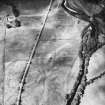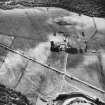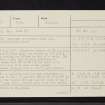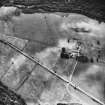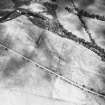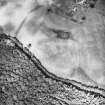Bochastle
Temporary Camp (Roman)
Site Name Bochastle
Classification Temporary Camp (Roman)
Alternative Name(s) Callander
Canmore ID 24351
Site Number NN60NW 3
NGR NN 61154 07726
NGR Description Centre
Datum OSGB36 - NGR
Permalink http://canmore.org.uk/site/24351
- Council Stirling
- Parish Callander
- Former Region Central
- Former District Stirling
- Former County Perthshire
NN60NW 3 centred 6117 0772.
(NN 614 076) Cropmarks of possible Roman camp.
Visible on J K St Joseph air photograph D 31.
Centred NN 6140 0751. Cropmarks showing the NE quadrants of two possible Roman camps are evident on St Joseph air photograph (D 31), but a mark running due N-S may be that of a drain. The site is flat, arable land in close proximity to Bochastle Roman fort (NN60NW 17) but there is no evidence of a camp to be seen on the ground.
Visited by OS (E G C) 24 October 1968.
NN 612 076: A temporary camp has been identified on level ground to the W of the fort (NN60NW 17); 875' of the E side, the rounded SE angle and the whole of the S side, 850' long, with a central gate, have been traced.
J K St Joseph 1973.
Nothing visible on the ground.
Visited by OS (J P) 28 April 1975.
Dimensions re-assessed as being about 530m from N to S by 365m transversely, the elongated plan being determined by the topography.
The presence of an internal linear cropmark suggested that it may have been reduced in size after construction.
G S Maxwell and D R Wilson 1987.
The Roman temporary camp at Bochastle lies to the W of the Roman fort (NN60NW 17) and encloses an area around and including Bochastle farm. The dimensions given by computer rectification suggest that it is some 570m in length running almost N-S, by 370m across. The interior linear cropmark would further reduce the transverse measurement to about 340m. This gives an overall area of approximately 21.1 or 19.4 hectares. There is a clavicula-gate entrance on the S side which has an oblique traverse, a clavicula and internal ditch beyond the traverse. There are also strong suggestions of an oblique traverse at the entrance on the N side, this is not so clear on the E and W sides, although there are other possible locations. The linear cropmark to the E of the camp at the SE angle is probably not of Roman origin.
Transcription file prepared by RCAHMS (RHM, MMB & GSM) 22 February 1996.
Information from RCAHMS (RHM) 17 September 1996.
In late February 1998, GUARD was commissioned by Historic Scotland to undertake an archaeological evaluation. The presumed northern defences of the camp, the surviving ditch of which is visible as a cropmark, are at present under threat from river erosion and Historic Scotland wished to sponsor an archaeological assessment in order to provide information in order to assist in the future management of the site.
No trace of the northern perimeter ditch was found. The most likely explanation for this is the presence of alluvial deposits in the area, caused by flooding of the Garbh Uisge, which have masked the archaeological deposits. Removal of these deposits would have constituted a breach of the scheduled monument consent terms and would have extended the evaluation beyond its budgetary limits. It remains likely that the Roman camp ditch lies beneath this alluvial layer.
P Duffy (GUARD) 1998; NMRS MS 725/173
NN 611 080 In February 1998 an archaeological evaluation was undertaken of the northern defences of Bochastle Roman temporary camp (NMRS NN60NW 3), in order to provide information to assist in the future management of the site. The camp is situated on an area of flat ground on the southern bank of the Garbh Usige, and is part of a larger Scheduled area, containing archaeological remains from several different periods, including the adjacent Roman fort. The northern defences of the camp are at present under threat from river erosion.
In total, four strip trenches were excavated at the site, three by a mechanical excavator, and one by hand. All were aligned N-S and positioned so as to transect the line of the northern defences as transcribed by RCAHMS from photographs taken in 1977.
No trace of the northern perimeter ditch was found. The most likely explanation for this is the presence of an alluvial deposit across the site, caused by flooding of the Garbh Usige, which has masked the archaeological deposits. The terms of the Scheduled Monument Consent prevented inspection beneath this layer during the fieldwork programme.
Sponsor: Historic Scotland
P Duffy 1998.
Field Visit (December 1977)
Bochastle 2 NN 611 077 NN60NW 3
Crop-marks show a Roman temporary camp about 21 ha in size.
RCAHMS 1979, visited December 1977
(St Joseph 1973, 224)
Aerial Photographic Transcription (28 November 1995 - 1 May 1996)
An aerial transcription was produced from oblique aerial photographs. Information from Historic Environment Scotland (BM) 31 March 2017.
Publication Account (17 December 2011)
The camps at Bochastle, lying immediately to the west of Bochastle Roman fort, were first discovered in 1945 by St Joseph from the air. The site lies to the west of Callander on low-lying ground between the Eas Gobhain and the Garbh Uisge in the upper reaches of the River Teith. The ground rises sharply to Bochastle Hill to the west. The dimensions of the camp are some 570m in length from north to south by 384m across, enclosing some 21.4ha (almost 53 acres). An interior linear cropmark in its western sector probably represents a secondary phase of use. This reduces the width of the camp (II ) to about 341m, enclosing an area of 19.5ha (just over 48 acres). The camp has Stracathro-type gates in its north and south sides; these lie opposite one another, east of the centre. No obvious gates are recorded in the east or west sides. Excavations on the north side of the camp in 1969 by St Joseph revealed a ditch which he interpreted as not conclusively Roman, measuring up to 4.2m wide and 1.4m deep (RCA HMS St Joseph Collection: Notebook 5). A further evaluation on the north side in 1988 revealed no archaeological remains (Duffy 1998a).
A small enclosure attached to the south part of the east side of the camp, close to the corner, may represent the remains of an annexe or attached camp, although its Roman origin is by no means confirmed. It measures 78m by at least 66m, thereby enclosing a minimum additional 0.53ha (1.3 acres). If it were Roman in date, it could relate to either phase of occupation of the camp site.
R H Jones 2011
Note (21 November 2022)
The location, classification and period of this site have been reviewed.













































